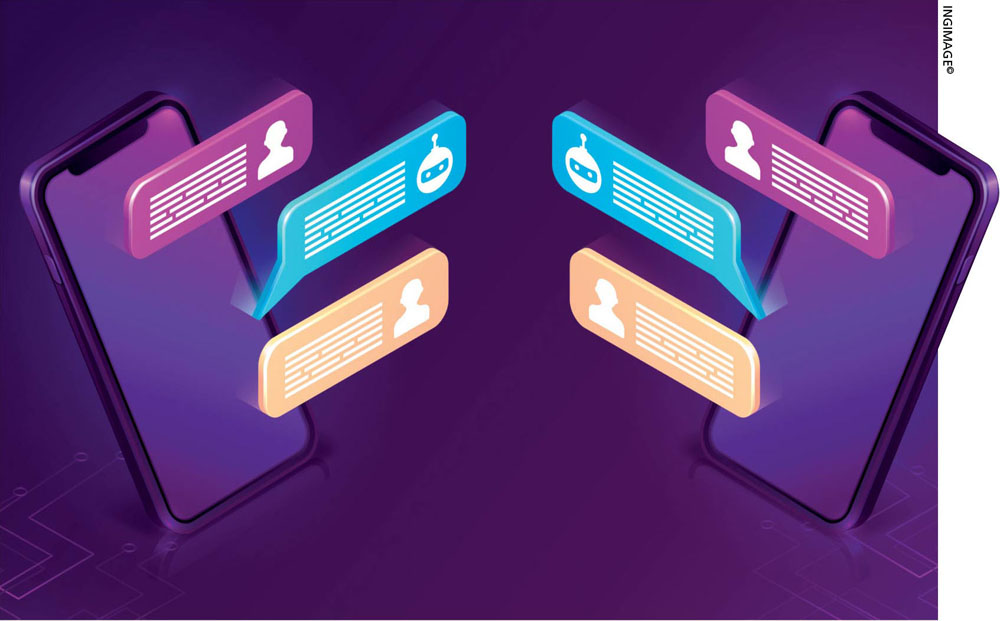CORPORATE TRAINING
CHATGPT AS A LEARNING TOOL
Sanjeewaka Kulathunga weighs the pros and cons of using chatbots for training
ChatGPT is a groundbreaking chatbot created by OpenAI. It combines artificial intelligence and machine learning, and enables people to interact with it in the same way they would with a human.
This state-of-the-art language model operating as a chatbot has immense potential to transform the landscape of corporate learning and development in the near future.
Generally, overhead projectors, whiteboards and lengthy presentations are used in corporate training to inculcate specialised skills or knowledge among employees. These training programmes are mundane and far from productive due to their monotonous nature.
But with the proliferation of AI in the corporate world, there could be major breakthroughs in corporate training and development. Learning and development teams use AI-powered solutions to optimise learners’ experiences, by delivering high quality content with real-time support and guidance.
Basically, ChatGPT is a deep learning model that has been trained on a large amount of text data – and can generate text with a high level of coherence and fluency. It can be used in a range of natural language processing applications including generating text for virtual assistants and chatbots, automatically summarising content and language translation.
So it can be employed as a personalised corporate trainer powered by AI to disseminate knowledge, and train and develop skills in employees of multinational companies (MNCs) around the globe without language or geographical barriers on a real-time basis.
For instance, when a new employee joins a manufacturing company, he or she must undergo multiple forms of training on the organisation’s rules and regulations, learn to use new equipment and machinery, how to take safety precautions and so on. The company could use ChatGPT to create a chatbot that directly interacts with him or her so the new recruit can learn at his or her own pace with personalised coaching and guidance.
Moreover, ChatGPT has the ability to customise virtual training experiences for businesses. Companies can provide employees with opportunities to be trained in a safe environment by simulating real world work scenarios. This is especially useful in industries where employees need to be trained on complex procedures or equipment, as it reduces costs and risks associated with on-site training.
ChatGPT can also be used to construct language learning tools to assist employees in becoming multilingual in the workplace on a global scale.
Moreover, it encourages businesses to develop an integrated knowledge management system.
ChatGPT can store and retrieve information quickly and efficiently within the organisation, and make it easier for strategic decision makers to obtain pertinent information and share expertise to make the right decisions at the right time – and thereby improve productivity.
However, its inherent shortcomings include the negative impact on organisational behaviour. While it can provide direction and feedback, ChatGPT can’t completely replace the human connection. The overuse of chatbots may impair employees’ communication and social skills, and undermine their ability to foster social relations that help retain collaborative momentum within a company.
Utilising chatbots for corporate training calls for a substantial investment of time and resources, including their creation and maintenance. They can be costly – especially for small to medium-size businesses or those that are on a tight budget.
Chatbots may not be able to accommodate all employees’ learning styles since some may prefer active learning methods where talks, activities and games are included in workshops with trainers and peers.
Overdependence on ChatGPT or chatbots may also hamper employees’ growth and development, thereby adversely impacting their performance. For example, if a company invests substantially in a chatbot for customer service, its staff may become overly reliant on technology. This could result in an unexpected loss in problem solving skills.
Excessive dependence may eventually hurt a company’s reputation since staff won’t be able to manage client inquiries that are outside the realm of the chatbot’s capabilities. Furthermore, technical problems with the chatbot may cause further delays and irritate clients.
Companies must strike a balance between using AI and ChatGPT to improve efficiency, and ensure that employees continue to learn and expand their abilities as a matter of course.
Even though the abilities of ChatGPT might prompt business leaders to believe that this emerging technology is a game changer in corporate learning and development – with amazing potential to become the most sought-after training tool of the future – its capabilities have still not been perfected.





